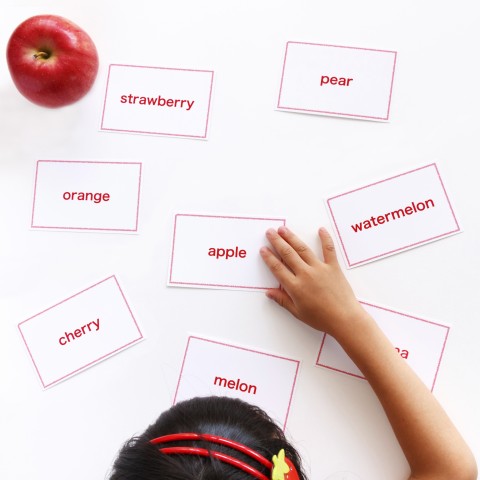
If you’re a native English-speaker looking to learn the beautiful Hindi language, you may have asked yourself “Is Hindi hard to learn?” Doubts like this are understandable, given the massive difference between the Hindi and English language scripts. However, not all answers are black and white.
There are a number of factors that can influence how easily you learn Hindi:
- Your background
- Your willingness to learn
- The Hindi teaching methods being used
Confident about the first two factors? Leave everything else to HindiPod101.com! We’re committed to making Hindi learning as interesting as possible.
 Table of Contents
Table of Contents
- Hindi: Yay or Nay!
- Why Should You Learn Hindi?
- The Most Easygoing Parts of Learning Hindi
- The Hardest Parts
- Handy Tips for a New Hindi Learner
- Why is HindiPod101.com Great for Learning Hindi?

Making Hindi Learning Fun for You!
1. Hindi: Yay or Nay!
You want to know how difficult (or easy!) learning Hindi will be for you. You want to know if you should take the plunge or not.
We won’t lie: Learning Hindi is no piece of cake! That said, there are some things that make Hindi hard to learn, and others that are very simple. Once you get the drift of it, you won’t be able to help falling in love with the language’s many amazing features. 🙂
For instance, Hindi is spoken just the way it’s written. Once you learn the alphabet, you’ve already won half the battle! (And with HindiPod101.com, you can learn the alphabet in no time.)
Now, let’s get going already and cover the basics of learning Hindi. In this article, we’ll give you some marvelous facts about the Hindi language, show you the good, bad, and ugly of the learning process, and give you tips for success along the way!
2. Why Should You Learn Hindi?
Why on earth would you want to learn Hindi? Honestly, the benefits are plenty, especially if you’re planning to stay in India for a while. Allow us to list some of the best reasons to learn Hindi with us.
1 – Wide Popularity
Hindi is one of the most spoken languages in India. Did you know that Hindi is the official language in a total of nine Indian states, collectively known as the Hindi Belt? But the language’s huge reputation doesn’t end there. In fact, natives of South India are quite familiar with the Hindi language as well. What’s more, take into account the massive fan base of Bollywood movies all over India—and the world—to see just how popular Hindi language media has become!
2 – Professional Benefits
Learning Hindi will open up many job opportunities for you. To say the least, it will give you a strong advantage in the Indian atmosphere. People in India are more inclined to hire someone who knows such a prevalent language like Hindi than someone who only knows English (or another less-popular language). When you know Hindi, they actually begin to see you as a part of their own society and culture.
3 – Social Mingling
Knowing at least a little Hindi will definitely give you an edge in many ways, from breaking the ice in conversations to dating someone. It will help you connect with natives and socialize with them in both personal and professional scenarios. This is especially true if you’re in Northern India, where conversing in Hindi is the real shortcut to people’s hearts.

Are You Studying the Right Way?
4 – Practical Advantages
Knowing Hindi will help you in a variety of daily activities, such as grocery shopping, bargaining for a lower price, taking a taxi, or asking for directions. It’s a life-saver in case of an emergency. Basic knowledge of Hindi will help you gel with neighbors and have fun at parties. You would have the luxury of laughing with natives when they make a joke (instead of feeling left out).
5 – Command Over Other Regional Languages
Hindi has inspired many other regional languages, such as Gujarati, Punjabi, Rajasthani, and Bihari. All of these languages spoken in the Northern area have many words in common. So, studying Hindi will automatically make you more familiar with these languages too, which is a big bonus!
3. The Most Easygoing Parts of Learning Hindi
Learning Hindi isn’t all fun and games, but there are a few aspects of the language that really aren’t so bad!
1 – Phonetic Language
When a language is phonetic, it means that it’s spoken exactly as it’s written. Once you learn to recognize the alphabet, there are no hidden or confusing pronunciation rules.
So, starting from scratch, your first priority should be to master the Hindi alphabet. Here are some examples of how Hindi may actually be easier than English in this regard:
- In English: Consider the sound of ‘u’ in “put” and “bush,” and then compare it to the sound of ‘u’ in “cut” and “rush.” They sound different, right? Moreover, “rough” and “cough” produce the sound of ‘f,’ whereas “though” and “plough” don’t.
- In Hindi: You won’t find such ambiguity in the Hindi language. Each sound or letter has one—and only one—way of being spoken. For example, घर (ghar) = “house,” घंटी (ghantii) = “bell,” and घूमना (ghuumaNaa) = “wander,” all generate the same sound of ‘gh’ as in “ghost.”
2 – Familiar Sounds
Although Hindi is a completely different language, it still has its fair share of common sounds with English. This factor turns things in the learner’s favor and fills them with some self-confidence from the beginning.

Start with the Basics
Delving into these familiar sounds right away and building a personal vocab list is an easy way to start practicing Hindi.
Examples of Familiar Sounds:
| Familiar Sounds | Hindi Examples | English Examples |
| अ (a) Sound |
| Used as [a] in “alone,” “about,” “aloof” |
| आ (aa) Sound |
| Used as [aa] in “farm,” “farmer,” “bark” |
| इ (i) Sound |
| Used as [i] in “still,” “fit,” “live” |
|
| Used as [ee] in “meat,” “sheep” |
| च (c) Sound |
| Used as [ch] in “cherry,” “chalk,” “chips” |
| ज (j) Sound |
| Used as [j] in “junk,” “jam,” “junior” |
3 – Plenty of English Words
Many borrowed English words have become a common part of our day-to-day Hindi. So, in a situation where the right Hindi word doesn’t come to your mind, you can get away with the survival English phrase for that word.
Given below are some Hindi sentences with common English words in them.
- मेरी शाम की फ़्लाइट है I (merii saam kii fLaait hai.)
“I have an evening flight.”
- क्या आज रात आप मेरे साथ डिनर करेंगे? (kyaa aaj raaT aap mere SaaTH diNar karenge?) [Talking to a male]
“Would you have dinner with me tonight?”
- क्या आज रात आप मेरे साथ डिनर करेंगी? (kyaa aaj raaT aap mere SaaTH diNar karengii?) [Talking to a female]
“Would you have dinner with me tonight?”
4 – Warm Culture
The quality of your surroundings plays a great role in how effectively you pick up new concepts. A warm and supportive atmosphere guarantees that you’ll learn faster and with more confidence. In the accommodating Indian culture, you’ll get all the encouragement needed to polish your Hindi language skills and speak like a native.
4. The Hardest Parts
Now it’s time to face the challenging parts. Given that Hindi is way out of league for any English-speaker, you’re bound to bump into some difficult stages during the learning process. So why is Hindi hard to learn, and how can you overcome these obstacles?
1 – Unfamiliar Sounds
This part is a nightmare for English-speakers. There are so many sounds in Hindi that non-native speakers are completely unaware of. Hence, it’s vital to focus on the pronunciation of unfamiliar sounds as soon as possible, because these concepts can get tricky.
Let’s look at a couple of these unique Hindi sounds.
| Unfamiliar Sounds | Hindi Examples | English Examples |
| त (T) Sound |
| Used as [t] in “pasta,” “restaurant” |
| ख/ख़ (kh) Sound |
| Used as [kh] in “Khan,” “Bach“ |
2 – Diacritics
Once you’ve spent some time on the unfamiliar letters and sounds, the second most important thing is to study Hindi grammar and diacritics (maaTraa) religiously. Otherwise, everything that follows will leave you puzzled.
Here are a few illustrations to show you how a little diacritic can turn the meaning of a word upside-down.
- भरा (bharaa) = “Full”
भूरा (bhuuraa) = “Brown”
- घंटी (ghantii) = “Bell”
घंटा (ghantaa) = “Hour”
- रोज़ (roz) = “Daily”
रोज़ा (rozaa) = “Fasting done by Muslims”
- फल (phaL) = “Fruit”
फूल (phuuL) = “Flower”
- पान (paaN) = “Betel leaf”
पानी (paaNii) = “Water”

How Can You Make Hindi Learning Easy?
3 – Gender-specific Conjugation
Let’s come back to the question, “Is Hindi hard to learn for English-speakers?” Up to a limit, the language can be pretty difficult, especially when it comes to something English-speakers aren’t familiar with in their own language: gender-specific conjugation.
In English, except for personal pronouns, there’s no grammatical gender to worry about. Sadly, that’s not the case in Hindi.
In the Hindi language, everything has a gender and the whole conjugation pattern changes accordingly.
Examples:
| Masculine Gender (Singular) | राम घर जा रहा है I (raam ghar jaa rahaa hai.) | “Ram is going home.” |
| Feminine Gender (Singular) | सीता घर जा रही है I (SiiTaa ghar jaa rahii hai.) | “Sita is going home.” |
| Masculine Gender (Plural) | दो आदमी सो रहे हैं I (Do aaDamii So rahe hain.) | “Two men are sleeping.” |
| Feminine Gender (Plural) | दो औरतें सो रही हैं I (Do auraTen So rahii hain.) | “Two women are sleeping.” |
4 – Homonyms
Homonyms are words that are spelled and pronounced identically, but have different meanings. Just like every language, Hindi is full of them. This may be bad news for beginners because it all comes down to context. Context is the only thing that hints at the correct meaning of a word in a given conversation.
- खाना (khaaNaa) = “To eat” (verb)
खाना (khaaNaa) = “Food” (noun)
- सोना (SoNaa) = “To sleep”
सोना (SoNaa) = “Gold”
- जग (jag) = “World”
जग (jag) = “Jug” (example: “jug of water”)
5 – Slang / Colloquial Words
Another feature that can really twist your mind is the Hindi texting slang, which can often be labeled untranslatable. It’s practically impossible to cover all of the texting slang and phrases you’ll come across, so please make sure to check out the links above and memorize as many words as possible.
Just to give you an idea, here are a couple of popular slang phrases:
- लंका लग गयी (Lankaa Lag gayii) = “Weird Sh*t Happens”
- ढाबा (dhaabaa) = “Roadside restaurant”

Practicing with the Natives
6 – Formal Tone
India is a country where tone matters. So much so that we have different ways of addressing elders versus young people. To be on the safer side, until and unless you’re well-acquainted with Indian culture, it’s better to use the formal tone for everyone without exception.
As a beginner, you may find it helpful to study this table about etiquette rules.
| Example Sentence: “What will you eat?” | |||
| Formal | Informal | Highly Casual | |
| For Addressing |
|
|
|
| Common Words Used | आप (aap) आपको (aap ko) | तुम (Tum) तुमको (Tum ko) | तू (Tuu)तुझे (Tujhe) |
| Addressing Males | आप क्या खाएंगे? (aap kyaa khaayenge?) | तुम क्या खाओगे? (Tum kyaa khaaoge?) | तू क्या खायेगा? (Tuu kyaa khaayegaa?) |
| Addressing Females | आप क्या खाएंगी? (aap kyaa khaayengii?) | तुम क्या खाओगी? (Tum kyaa khaaogii?) | तू क्या खायेगी? (Tuu kyaa khaayegii?) |
5. Handy Tips for a New Hindi Learner
Everybody could use some help, especially beginners. With these valuable tips and methods, you can make your learning journey more interesting and unconventional.
1 – Watch Movies and TV Shows
We all learn faster when it’s fun. So, the first way to drive away boredom is to start watching hit Bollywood movies. It’s even better if they have subtitles in your mother tongue. If you’re not into films, you can opt for Hindi songs or TV shows in your favorite genre. Check out our list of the Top Hindi TV Shows to get started.

Don’t Study Hard. Study Smart.
2 – Listen to Audiobooks
Listening to audiobooks or radio programs in Hindi can be really useful when you’re getting started. It’s especially time-efficient when you’re stuck in traffic or commuting by metro. For more tech-savvy learning, feel free to check out our free Hindi audiobooks.
3 – Practice with Native Speakers
On a regular basis, talk to someone who’s a native Hindi-speaker. There’s nothing like gaining first-hand experience with natives. Moreover, practicing with native folks means you’ll get instant feedback, cultural tips, and information on minute details. And, hold on, isn’t it so much more fun!
4 – Review Everyday
If you don’t review and revise often, you’ll lose all of the progress you’ve made! Imagine planting a tree every day but forgetting to water them. The same is the case with studying Hindi. Revision and practice are almost as necessary as learning something new.
5 – Don’t Be Afraid to Ask
When confused about something, ask. It’ll save you from embarrassment later. Remember, Indians are generous when it comes to assisting others. They don’t mind stopping what they’re doing to help you out. So, shake off any hesitation and reach out to them. People will actually respect you more because of your interest in their native language.
6. Why is HindiPod101.com Great for Learning Hindi?
By now, you may be wondering what makes HindiPod101.com so special. Why should someone choose this platform above all the others? Read on to find out the unique perks and facilities HindiPod101.com has to offer you—unbeatable features that you’ll find nowhere else. Let’s dig in!
1 – World-Class Materials
From free PDFs to quality learning materials, grammar exercises, and countless video and audio lessons, we’ve got everything to help you speak Hindi fast. Our students also enjoy using flashcards, a free Hindi-English dictionary, a comprehensive grammar bank, and our fun Word of the Day feature!
2 – Effective Strategies
We know how hard learning Hindi can be. But there’s always a way to get through in one piece! HindiPod101.com shares various effective strategies to keep things simple for you. These may include pinpointing your favorite way of learning Hindi, using quick memory techniques, etc.

Slow and Steady Wins the Race
3 – Customized Learning
Do you want to learn Hindi to get a better job? Are you trying to date someone in India? Maybe you just need some survival phrases in Hindi for a quick visit. Whatever your purpose for learning Hindi, just let us know and we’ll create a Learning Path that specially caters to your needs and goals.
4 – Personal Assistance
Got a question? The MyTeacher Messenger is there to help you with your doubts 24/7. All you have to do is sign up at our website and become a Premium PLUS student. A Hindi teacher will be assigned to you for all your language-related questions. Just leave a message and your teacher will respond back within a few hours. How cool is that!
5 – Hindi at Your Fingertips!
We want nothing to stand between you and your desire to study Hindi. That’s why HindiPod101.com has designed a brilliant, user-friendly app for learning Hindi whether you’re feeling lazy or have a jam-packed schedule. Now you can improve your Hindi skills no matter where you are.
Let us know in the comments how you feel about learning Hindi now. More confident, or do you still have some questions or concerns? We look forward to hearing from you!

How to Avoid the Top 10 Common Mistakes in Learning Hindi

Mistakes are a part of life. But some of them may get us in trouble or in quite an embarrassing situation. This is especially true when learning a new language.
Being a non-native, you may have already experienced the pain of making common Hindi grammar mistakes. Honestly, we feel you! But we can’t bend the rules for you. After all, it’s a language, something you can’t mess with!

Mistakes are a part of life!
But we’re not saying that you can’t do anything about it. There are several ways that you can make the learning process easier on yourself and plenty of strategies to get ahead of others.
So, in this lesson, we’ll be sharing some quick tricks and tips on how to avoid spelling mistakes in the Hindi language, in addition to common grammatical errors.
Let’s get started, guys!
 Table of Contents
Table of Contents
- Oh, the Curse of Phonetics!
- The Gender Conflict
- Confusing Homonyms
- “Where” to Place “What” and “Why”!
- The Politeness Code
- Stay Away from Redundancy
- Clever Diacritics
- When to Skip the jii Suffix
- The Local Dialect
- The Fear of Making Mistakes
- Overcoming Your Hindi Mistakes with HindiPod101.com
1. Oh, the Curse of Phonetics!
Well, as they say, eat your frogs first. Phonetics is a real pain for any Hindi language learner. And it’s scary as hell. So, let’s tackle that first.
Common Hindi pronunciation mistakes abound when new learners begin speaking the language. Whether it’s the accent, the pronunciation, or the stretch of a syllable, this one is a head-scratcher. But HindiPod101.com has your back!
Before this scary monster begins to overpower your abilities and crush your self-confidence, check out our comprehensive guide on Hindi pronunciation. It will give you deep insight into the micro-concepts of the language and help you learn faster.
When studying Hindi, there are certain facts worth knowing about the language. We’ll do our best to cover these facts in the following sections.
1 – Writing System
- Hindi follows an alphasyllabary writing system, where each combination of consonants and vowels is taken as a unit.
| Example | क + म + र + आ = कमरा (kamaraa) = “room” (ka) + (ma) + (ra) + (aa) |
2 – Unfamiliar Sounds
- There are a handful of new sounds in Hindi that are completely unfamiliar to non-natives. So, it’s quite possible to get confused while pronouncing them.
| Examples of Unfamiliar Sounds |
| त (T) = This is the soft sound of [t] as used in “barista” or in the Italian pronunciation of “pasta.” |
| त्र (Tr) = This is the coupled sound of soft [T] + [r] to make [Tr], as in “Dmitrij” or the Italian pronunciation of “restaurant.” |
| ख or ख़ (kh) = This is the coupled sound of [k] + [h] to make [kh], as in “Khan” or “Bach.” Of course, both are loan words from the Urdu and German languages, because there’s no such English word with the “-kh” sound. |
And we’re not even close to covering all the points which so frequently lead to the most common Hindi pronunciation mistakes.
3 – Syllables
- A longer or shorter stretch of a syllable may completely change the meaning of a word.
| Syllable Examples | Longer Stretch | Shorter Stretch |
| पेट | Spoken as (pet) as in “gate” or “late” पेट (pet) = “stomach” / “belly” | Spoken as (pet) as in “get” or “set” पेट (pet) = “pet animal” |
| जेल | Spoken as (jeL) as in “bale” or “tail” जेल (jeL) = “prison” | Spoken as (jeL) as in “tell” or “fell” जेल (jeL) = “gel” |
Now, don’t sweat over it. These concepts may feel overwhelming, but with time and practice, you’ll soon be able to master them. 🙂

Slow and Steady Wins the Race
2. The Gender Conflict
You probably know that English verbs are gender-neutral, and that only the pronouns vary based on gender. However, that’s not the case in the Hindi language.
Using the wrong gender-verb conjugation is one of the most common Hindi grammar mistakes. And it’s totally understandable because, for a beginner, the rules can be tricky at times.
Nonetheless, we have one secret code that will not only help you catch the tiger by its tail, but also tame it.
| Feminine Gender | All of the verbs and other conjugations end with the -ii sound. This rule applies to both singular and plural nouns/pronouns. |
| Examples | जाती है (jaaTii hai) = “goes” सोती है (SoTii hai) = “sleeps “खाती है (khaaTii hai) = “eats” |
| Masculine Gender | For the singular masculine gender, all of the verbs and other conjugations end with the -aa sound. For the plural masculine gender, all of the verbs and other conjugations end with the -e sound. |
| Singular Examples | जाता है (jaaTaa hai) = “goes” सोता है (SoTaa hai) = “sleeps” खाता है (khaaTaa hai) = “eats” |
| Plural Examples | जाते हैं (jaaTe hain) = “go” सोते हैं (SoTe hain) = “sleep” खाते हैं (khaaTe hain) = “eat” |
What we’ve covered here are just the basic rules of thumb to help you avoid conjugation-related Hindi grammar mistakes. In fact, the conjugation rules vary according to the tense, mood, and tone as well. For the more curious souls, have a look at our amazing Verb Conjugation article!
3. Confusing Homonyms
Even if you think you’ve mastered how to avoid spelling mistakes in the Hindi language, there are always things that can go wrong. Why? Because not everything has a shortcut. So, don’t judge yourself or be super-critical about minor mistakes.
Some skills take time to develop and grow. Remember: Slow and steady wins the race! 😉
One of the most troublesome concepts is that of “homonyms.” And mind you, these pairs of words are the exact copies of each other. It’s so easy for beginners to make a mistake in Hindi here without the proper experience and exposure. The only way to crack the code and differentiate between their meanings is by looking at the entire context of a conversation.

Messed up in a meeting because you said the wrong word?
Here are a few common homonyms that are easily confused.
| Hindi Word | English Meaning 1 | English Meaning 2 |
|---|---|---|
| कल (kaL) | “Yesterday” | “Tomorrow” |
| फल (phaL) | “Gold” (noun) | “To sleep” (verb) |
| फल (phaL) | “Fruits” (noun) | “Result” / “Outcome” |
| खाना (khaaNaa) | “Food” (noun) | “To eat” (verb) |
4. “Where” to Place “What” and “Why”!
Before we continue, some good news for you: We’re almost halfway through this lesson. Yay! Give yourself a pat on the back!
Don’t get too carried away, though, because we have another brain teaser waiting for us.
Now, we’ll be talking about the Hindi sentence pattern and word order. Or, to be precise, about where you should place interrogative words when asking a question. Pay attention, because confusion on this topic leads to many Hindi mistakes!
Unlike in English, in Hindi, we place the interrogative words right before the helping verb or main verb. Just for easy reference, here are a few common Hindi question words:
- क्या (kyaa) = “what”
- कब (kab) = “when”
- कहाँ (kahaan) = “where”
- क्यों (kyon) = “why”
5. The Politeness Code
Offending someone is the last thing you want to do in a foreign country. In India, following the proper code of conduct and showing respect and courtesy matter a lot.
Just like people in many Asian countries, we Indians have particular words and phrases we use to show respect to our elders, strangers, and other people in formal situations. We’ll admit that this isn’t so much a set of Hindi mistakes as it is a cultural difference.
So, whenever you’re meeting someone:
- for the first time;
- elderly;
- of the opposite gender;
- officially senior to you;
- who is a stranger,
Our rule of thumb is to go with the word आप (aap) rather than तुम (Tum). Both words are Hindi translations for the pronoun “you.” But remember that आप (aap) is more than just a word; it’s a gesture of showing respect and proper etiquette.
6. Stay Away from Redundancy
A frequent mistake Hindi-learners make is to crowd a sentence with unnecessary words. Well, honestly, the crime of redundancy is not unique to Hindi, but it’s still important to cover.
First of all, repetitive words make us sound clumsy and cluttered. Redundancy steals the sharpness and freshness from our sentences and turns them into long, boring lines.

Mastering Hindi the fun way!
Here are a few examples of common mistakes that are made while learning Hindi.
| Example 1 | Hindi Sentence | Literal English Meaning |
| Wrong Way | मैं तुमसे सोमवार के दिन मिलूंगा Imain Tum Se Somavaar ke DiN miLuungaa. | “I will meet you on the day of Monday.” |
| Right Way | मैं तुमसे सोमवार को मिलूंगा Imain Tum Se Somavaar ko miLuungaa. | “I will meet you on Monday.” |
| Example 2 | Hindi Sentence | Literal English Meaning |
| Wrong Way | ट्रेन को आने में दो घंटे का समय लगेगा ItreN ko aaNe men Do ghante kaa Samay Lagegaa. | “The train will arrive in two hours of time.” |
| Right Way | ट्रेन को आने में दो घंटे लगेंगे ItreN ko aaNe men Do ghante Lagenge. | “The train will arrive in two hours.” |
| Example 3 | Hindi Sentence | Literal English Meaning |
| Wrong Way | क्या मुझे एक गिलास पीने का पानी मिलेगा?kyaa mujhe ek giLaaS piiNe ka paaNii miLegaa? | “Can I get a glass of drinking water?” |
| Right Way | क्या मुझे एक गिलास पानी मिलेगा?kyaa mujhe ek giLaaS paaNii miLegaa? | “Can I get a glass of water?” |
As you can see, the phrases “the day of,” “of time,” and “drinking” in Examples 1, 2, and 3 respectively, are unnecessary. Removing them from the sentence doesn’t affect the meaning at all. In fact, removing those words helps us construct shorter, cleaner statements.
7. Clever Diacritics
Make no mistake! Hindi diacritics are a total game-changer. They can make you or break you. But what is a diacritic, anyway? Check out our lesson to find more information about the Hindi maatraa.
Assuming that you have a little bit of an idea about the Hindi maatraa, let’s see how missing a seemingly innocent sign here and there can completely distort the meaning of your statement.
| सुना (SuNaa) = “Listened” / “Heard” सूना (SuuNaa) = “Feeling empty” / “Deserted” |
| काम (kaam) = “Work” कम (kam) = “Less” / “Few” |
| दिन (DiN) = “Day” दीन (DiiN) = “Poor” / “Underprivileged” |
| सिलना (SiLaNaa) = “To sew” सीलना (SiiLaNaa) = “Damp” / “Soggy” |
| ओर (or) = “Toward” और (aur) = “And” |
As you can see, a slight change in diacritics can greatly change a word’s meaning. Ignorance about the significance of diacritics is another common mistake Hindi-learners make, so watch out for these!
8. When to Skip the jii Suffix
It’s always okay, and especially important, to add the जी (-jii) suffix when calling an elder person by their name. The one and only condition where using जी (-jii) may do you more harm than good, is when you attach it to your own name.
Yeah, that could leave your Indian friends laughing out loud. It just doesn’t go well with our own names. So, always remember to avoid getting into this pitfall, because it’s a natural mistake that Hindi grammar lessons don’t often talk about!

9. The Local Dialect
Nearly every language can be said to have its own colloquial words. This may include synonyms, regional accents, local dialects, and so on. So, basically, a word can have the same meaning in different dialects, even if each dialect says it quite differently.
To give you an idea, let’s recall words like “yeah” / “yup” / “ya” which all mean “yes.” Similarly, we also use “buddy” / “bud” / “pal” / “man” / “dude,” all of which mean the same thing.
Likewise, in Hindi, a category of similar words may confuse a beginner. What are these words? Well, here are some examples:
| Interchangeable Hindi Words | English Meaning |
| वह (vah) / वो (vo) | “He” / “She” / “That” |
| सब (Sab) / सारे (Saare) / सभी (Sabhii) | “All” / “Everyone” |
| क्यों (kyon) / काहे (kaahe) / किसलिए (kiSLiye) | “Why” |
| कहाँ (kahaan) / किधर (kidhar) | “Where” |
You get the drift, right? It’s not a matter of one phrase being right and the others being wrong. It’s just a matter of preference by the individual or the regional dialect.

How to avoid those oops moments!
10. The Fear of Making Mistakes
You’ve now learned how to improve Hindi mistakes that new learners make, and most of them are quite easy to fix. But what about the biggest mistake?
Face your fears and don’t be ashamed of your common Hindi grammar mistakes. Have you seen a child falling again and again when trying to walk for the first time? We don’t call their fall a failure or mistake, do we? We take it as part and parcel of learning.
In our mind, we know that it’s practically impossible for him or her to crawl one day and start walking perfectly the next day. The same is true of Hindi language-learning. As long as you’re afraid of making mistakes, you’ll never learn to move forward.
So, instead of acting on the natural tendency to escape, it’s time to master the tips from this article on how to avoid Hindi language mistakes.
11. Overcoming Your Hindi Mistakes with HindiPod101.com
All right! We’ve finally covered all of the common mistakes in learning Hindi and tips on how to avoid them. We hope this lesson has been useful and easy for you to understand.
If you have any doubts or questions, reach out to us at MyTeacher Messenger. All you need to do is download our free mobile app and start learning.
Is there anything we didn’t cover in this article that you want to know about? Share your thoughts with us in the comments below and connect with other learners as well!
Happy Hindi learning!

Top 10 Conversation Questions in Hindi & How to Answer Them

“What’s up?”
“May I know your name?”
“Oh, how are you?”
These are simple questions that carry the potential to bond two people, and they serve as great conversation starters. Today, you’ll learn and practice similar English-to-Hindi question-answer patterns that are popular in Indian society. These on-the-spot questions to ask in Hindi will help you break the ice and, on some occasions, save you from unnecessary challenges.
Before we start, you may want to get familiar with the most common Hindi question words. We have relevant lessons on our website that you can check out for the question words “what,” “where,” and “when.”
Now, there may be a ton of survival interrogative phrases. But let’s be honest: we can’t cram everything into just one lesson. So, here’s the deal. We’ll bring you the ten best conversation questions in Hindi and teach you different ways to answer them.
You’ll also learn the English meaning of each and every Hindi word while practicing the various sentence structures.
| Quick Note: As this lesson mainly focuses on the top Hindi questions, we’ll only be explaining each word from the questions, instead of covering both Q&A. |
Let’s begin the adventure and check out the ten most popular question sentences in Hindi!
 Table of Contents
Table of Contents
- What’s in a name, after all?
- How do you do?
- Where are you from?
- What do you do for a living?
- Do you speak Hindi?
- How is everyone in the family?
- Time, please?
- Would you like to have something?
- What’s wrong?
- How much is it?
- Ice-Breaking with HindiPod101.com
1. What’s in a name, after all?
Well, a lot. The first personal thing we get to know about someone is his/her name. If it’s your first conversation with this person, then this is certainly one of the good questions to ask a Hindi native.
You’ll not only sweep them off their feet, but you’ll also enjoy the credit of breaking the ice!
In a nutshell, asking somebody’s name is one of the top Hindi questions you need to know in India. Luckily, doing so isn’t that hard.
So, here we go!
| Q. | आपका नाम क्या है? aap kaa Naam kyaa hai? | “What’s your name?” |
| A. | मेरा नाम मनीषा है। meraa Naam maNiisaa hai. | “My name is Manisha.” |
| Hindi | English | Romanization | |
| Word 1 | आपका | “your” | aap kaa |
| Word 2 | नाम | “name” | Naam |
| Word 3 | क्या | “what” | kyaa |
| Word 4 | है | “is” | hai |
| Q. | आपका शुभ नाम क्या है? aap kaa subh Naam kyaa hai? | “What’s your good name?” |
| A. | मेरा नाम अदित है। meraa Naam aDiT hai. | “My name is Adit.” |
| Hindi | English | Romanization | |
| Word 1 | आपका | “your” | aap kaa |
| Word 2 | शुभ | “good” | subh |
| Word 3 | नाम | “name” | Naam |
| Word 4 | क्या | “what” | kyaa |
| Word 5 | है | “is” | hai |
Voila! You’ve just mastered the very first conversation questions in Hindi! Wasn’t that easy? Based on the patterns of these basic Hindi questions and answers, you can see how your answer should be constructed. All you need to do is insert your name in place of the example name.

2. How do you do?
Okay, how do you show your care and concern for somebody? By asking how they are. This etiquette rule applies all over the world, and India is no exception. Because this is so important for strengthening any relationship, we’ll show you some simple Hindi questions and answers you can expect.
These may be easy questions to ask in Hindi, but they’re also a sureshot way to touch someone’s heart. One simple question, and they may pour out their pain, sadness, joy, or happiness to you in a moment. And an experience like that can make you feel so precious and strengthen your bond with that person.
| Q. | कैसे हैं आप? kaiSe hain aap? | “How are you?” |
| A. | मैं ठीक हूँ। main thiik huun. | “I’m good/okay.” |
| A. | मैं परेशान हूँ। main paresaaN huun. | “I’m worried.” |
| A. | मैं ख़ुश हूँ। main khus huun. | “I’m happy.” |
| A. | मैं नाराज़ / उदास हूँ। main Naaraaz / uDaaS huun. | “I’m upset/sad.” |
| Hindi | English | Romanization | |
| Word 1 | कैसे | “how” | kaiSe |
| Word 2 | हैं | “are” | hain |
| Word 3 | आप | “you” | aap |
Above, we outlined the Hindi questions with answers for a variety of circumstances. This will allow you to become more fluent when using conversational Hindi questions, as you’ll be able to understand (or give) different answers.
| Q. | क्या हाल-चाल हैं? kyaa haaL-caaL hain? | “How do you do?” |
| A. | बिल्कुल बढ़िया! biLkuL badhiyaa! | “Great!” / “Absolutely fine!” |
| A. | बकवास! bakavaaS! | “Terrible!” |
| Hindi | English | Romanization | |
| Word 1 | क्या | “what” | kyaa |
| Word 2 | हाल-चाल | “well-being” | haaL-caaL |
| Word 3 | हैं | “are” | hain |
Here are some of the best Hindi adjectives to help you express the various shades of your moods.
3. Where are you from?
Now, what are some general Hindi questions and answers that you can expect as a foreigner in India?
Well, our third question is for asking where someone is from.
In this day and age, when the whole world has become a global village, people from all cultures and places can meet each other. In such circumstances, asking about someone’s hometown/country is inevitable.
And given India’s warm and social culture, you’ll find yourself either asking or answering Hindi questions like these often. So, check out these questions and impress the natives with your fluent Hindi.
| Q. | आप कहाँ से हैं? aap kahaan Se hain? | “Where are you from?” |
| A. | मैं भारत से हूँ। main bhaaraT Se huun. | “I’m from India.” |
| A. | मैं जापान से हूँ। main jaapaaN Se huun. | “I’m from Japan.” |
| A. | मैं रूस से हूँ। main ruuS Se huun. | “I’m from Russia.” |
| Hindi | English | Romanization | |
| Word 1 | आप | “you” | aap |
| Word 2 | कहाँ | “where” | kahaan |
| Word 3 | से | “from” | Se |
| Word 4 | हैं | “are” | hain |
If you’re located in India or currently living there, people may ask you the same thing, but in a slightly different way.
| Q. | आपका घर कहाँ हैं? aap kaa ghar kahaan hai? | “Where do you live?” |
| A. | मेरा घर लाजपत नगर में है। meraa ghar LaajapaT Nagar men hai. | “I live in Lajpat Nagar.” |
| Hindi | English | Romanization | |
| Word 1 | आपका | “your” | aap kaa |
| Word 2 | घर | “home” | ghar |
| Word 3 | कहाँ | “where” | kahaan |
| Word 4 | है | “is” | hai |
4. What do you do for a living?
Indians are quite upfront and casual when it comes to asking about others’ source of living. What you do and how you explain your work may have a wonderful impression on the locals. So why waste the chance to leave them speechless with your amazing Hindi vocab?
And while we’re at it, it won’t take long to check out these straight-to-business questions and answers in Hindi!
| Q. | आप क्या करते हैं? aap kyaa karaTe hain? | “What do you do?” |
| A. | मैं टीचर हूँ। main tiicar huun. | “I’m a teacher.” |
| A. | मैं वक़ील हूँ। main vaqiiL huun. | “I’m a lawyer.” |
| A. | मैं कलाकार हूँ। main kaLaakaar huun. | “I’m an artist.” |
| Hindi | English | Romanization | |
| Word 1 | आप | “you” | aap |
| Word 2 | क्या | “what” | kyaa |
| Word 3 | करते | “do” | karaTe |
| Word 4 | हैं | “are” | hain |
| Q. | आप क्या काम करते हैं? aap kyaa kaam karaTe hain? | “What’s your profession?” |
| A. | मैं तैराकी सिखाती हूँ। main Tairaakii SikhaaTii huun. | “I teach swimming.” |
| A. | मैं होटल में मैनेजर हूँ। main hotaL men maiNejar huun. | “I’m a hotel manager.” |
| Hindi | English | Romanization | |
| Word 1 | आप | “you” | aap |
| Word 2 | क्या | “what” | kyaa |
| Word 3 | काम | “work” | kaam |
| Word 4 | करते | “do” | karaTe |
| Word 5 | हैं | “are” | hain |
Yes, having your own business or being in a job does make a difference in Indian society. In fact, if you could grab a government job, you’d be treated as nothing less than a king/queen. However, things are changing and people are becoming more open-minded (though there’s still a long way to go for us Indians).
In your first few meetings, talking about each other’s professions falls under the category of good questions to ask a Hindi speaker. So, if you’re out of ideas, feel free to use such questions for a friendly chat.
| Q. | आप व्यापार करते हैं या नौकरी? aap vyaapaar karaTe hain yaa Naukarii? | “Are you in a business or job?” |
| A. | मेरा ख़ुद का ब्यूटी पार्लर (व्यापार) है। meraa khuD kaa byuutii paarLar (vyaapaar) hai. | “I run my own beauty parlor (business).” |
| A. | मैं जिम में काम करता हूँ। main jim men kaam karaTaa huun. | “I work at a gym.” |
| Hindi | English | Romanization | |
| Word 1 | आप | “you” | aap |
| Word 2 | व्यापार | “business” | vyaapaar |
| Word 3 | करते | “do” | karaTe |
| Word 4 | हैं | “are” | hain |
| Word 5 | या | “or” | yaa |
| Word 6 | नौकरी | “job” | Naukarii |
5. Do you speak Hindi?
Some of you may be surprised to know that not all Indians speak Hindi. In fact, there are more than twenty local Indian languages spoken in different parts of the country.
The bottom line is that whenever you meet an Indian, it’s better not to assume that they speak Hindi.

Can you speak Hindi?
Here are the basic Hindi questions and answers you can use to ask about someone’s Hindi-speaking abilities or answer about your own.
| Q. | क्या आप हिंदी समझते / बोलते हैं? kyaa aap hiNDii SamajhaTe / boLaTe hain? | “Do you understand/speak Hindi?” |
| A. | हाँ, मुझे ठीक-ठाक हिंदी आती है। haan, mujhe thiik-thaak hinDii aaTii hai. | “Yeah, my Hindi is alright.” |
| A. | हाँ, मुझे बहुत अच्छी हिंदी आती है। haan, mujhe bahuT acchii hinDii aaTii hai. | “Yeah, I am quite fluent in Hindi.” |
| A. | नहीं, मुझे ज़्यादा हिंदी नहीं आती। Nahiin, mujhe zyaaDaa hinDii Nahiin aaTii. | “No, I don’t know much Hindi.” |
| Hindi | English | Romanization | |
| Word 1 | क्या | “do” | kyaa |
| Word 2 | आप | “you” | aap |
| Word 3 | हिंदी | “Hindi” | hinDii |
| Word 4 | समझते | “understand” | SamajhaTe |
| Word 5 | बोलते | “speak” | boLaTe |
| Word 6 | हैं | “are” | hain |
6. How is everyone in the family?
Family holds a special place in every part of the world, and this may be even more true for Indians than for most other people.

How’s your family?
So whenever you bump into a local friend, remember that family is definitely a topic of choice if you need some good questions to ask a Hindi native and melt his or her heart.
| Q. | घर में सब कैसे हैं? ghar men Sab kaiSe hain? | “How’s everyone in the family?” |
| A. | घर में सब ठीक हैं। ghar men Sab thiik hain. | “Everything’s great at home.” |
| Hindi | English | Romanization | |
| Word 1 | घर | “home” / “family” | ghar |
| Word 2 | में | “in” | men |
| Word 3 | सब | “everyone” | Sab |
| Word 4 | कैसे | “how” | kaiSe |
| Word 5 | हैं | “are” | hain |
| Q. | और सब ठीक-ठाक है? aur Sab thiik-thaak hai? | “Everything’s well in the family?” |
| A. | जी, सब अच्छा है। jii, Sab acchaa hai. | “Yeah, everything’s going great!” |
Do you know what we call family members in Hindi? Here’s our quick list for family members in India. Have a look!
| Hindi | English | Romanization | |
| Word 1 | और | “and” | aur |
| Word 2 | सब | “everything” | Sab |
| Word 3 | ठीक-ठाक | “okay” | thiik-thaak |
| Word 4 | है | “is” | hai |
7. Time, please?
Isn’t it remarkable to learn so many Hindi question words in just one lesson? Well, don’t worry. We still have plenty of material for you in this guide.
This section is about asking for the time, which is another really important and practical question in Hindi. Before we teach you how to ask a Hindi question about time, you might like to take a sneak-peek at our Tell the Time in Hindi lesson for a more thorough knowledge.
| Q. | कितने बज रहे हैं? kiTaNe baj rahe hain? | “What’s the time?” |
| A. | सुबह के सात बज रहे हैं। Subah ke SaaT baj rahe hain. | “It’s seven in the morning.” |
| Hindi | English | Romanization | |
| Word 1 | कितने | “what” | kiTaNe |
| Word 2 | बज | “time” / “o’clock” | baj |
| Word 3 | रहे | “happening” | rahe |
| Word 4 | हैं | “are” | hain |
| Q. | वक़्त क्या हो रहा है? vaqT kyaa ho rahaa hai? | “What’s the time?” |
| A. | दो बज रहे हैं। Do baj rahe hain. | “It’s two o’clock.” |
| Hindi | English | Romanization | |
| Word 1 | वक़्त | “time” | vaqT |
| Word 2 | क्या | “what” | kyaa |
| Word 3 | हो रहा | “happening” | ho rahaa |
| Word 4 | है | “is” | hai |
8. Would you like to have something?
We all like to treat our guests in the best possible way. Suppose you’re on a date or having lunch with a colleague/friend. Wouldn’t it be marvelous to welcome them with some Hindi greetings?

Hey, would you like to eat with us?
Fortunately, there are many ways to impress people, and you can choose whichever sounds easiest and more apt to you.
Without further ado, here are the most popular Hindi questions and answers when welcoming your guests.
| Q. | क्या लेना पसंद करेंगे? kyaa LeNaa paSaND karenge? | “What would you like to have?” |
| A. | मैं एक कप चाय ले लूँगी। main ek kap caay Le Luungii. | “I’ll have a cup of tea.” |
| Hindi | English | Romanization | |
| Word 1 | क्या | “what” | kyaa |
| Word 2 | लेना | “take” | LeNaa |
| Word 3 | पसंद | “like” | paSaND |
| Word 4 | करेंगे | “do” | karenge |
| Q. | कुछ चाहिए? kuch caahiye? | “Do you want something?” |
| A. | जी, मुझे पानी पीना है। jii, mujhe paaNii piiNaa hai. | “Yeah, I’d like to have some water.” |
| Hindi | English | Romanization | |
| Word 1 | कुछ | “something” | kuch |
| Word 2 | चाहिए | “want” / “need” | caahiye |
| Q. | चाय पिएंगे या ठंडा? caay piyenge yaa thandaa? | “Would you have something hot or cold?” |
| A. | जी, मैं शरबत लूँगा। jii, main sarbaT Luungaa. | “Yeah, I’ll have sherbet.” |

Some fresh juice, please?
| Hindi | English | Romanization | |
| Word 1 | चाय | “tea” | caay |
| Word 2 | पिएंगे | “will drink” / “have drink” | piyenge |
| Word 3 | या | “or” | yaa |
| Word 4 | ठंडा | “cold drink” | thandaa |
9. What’s wrong?
Now, you don’t want to miss out on the Hindi phrases you’ll need when something goes wrong!
After all, when sad, all one wants is someone to show that they care. So, if you see that your friend’s feeling low, just asking these simple things may lighten their mood, and they may just share their feelings with you.
| Q. | क्या हुआ? kyaa huaa? | “What happened?” |
| A. | मेरी तबियत ठीक नहीं है। merii TabiyaT thiik Nahiin hai. | “I’m not feeling well.” |
| A. | नहीं, कुछ नहीं हुआ। Nahiin, kuch Nahiin huaa. | “No, everything’s alright.” |
| Hindi | English | Romanization | |
| Word 1 | क्या | “what” | kyaa |
| Word 2 | हुआ | “happened” | huaa |

Is something wrong?
| Q. | कोई बात है क्या? koi baaT hai kyaa? | “Is something wrong?” |
| A. | मेरा झगड़ा हुआ है। meraa jhagadaa huaa hai. | “I’ve had a fight.” |
| A. | नहीं, कुछ नहीं हुआ। Nahiin, kuch Nahiin huaa. | “No, everything’s alright.” |
| Hindi | English | Romanization | |
| Word 1 | कोई | “something” | koi |
| Word 2 | बात | “wrong” | baaT |
| Word 3 | है | “is” | hai |
| Word 4 | क्या | “what” | kyaa |
10. How much is it?
Our final section is related to shopping, bargaining, asking prices, and so on. Practice these phrases and grab yourself the best deal in the market by proving your Hindi knowledge.
| Q. | इसका दाम क्या है? iS kaa Daam kyaa hai? | “What’s the price of this?” |
| A. | इसका दाम पचास रुपये है। iS kaa Daam pacaaS rupaye hai. | “It’s fifty bucks.” |
| Hindi | English | Romanization | |
| Word 1 | इसका | “its” | iS kaa |
| Word 2 | दाम | “price” | Daam |
| Word 3 | क्या | “what” | kyaa |
| Word 4 | है | “is” | hai |

Oh, what’s that?
| Q. | ये कितने का है? ye kiTaNe kaa hai? | “How much is this?” |
| A. | ये सात सौ बीस रुपये का है। ye SaaT Sau biiS rupaye kaa hai. | “It’s seven hundred and twenty rupees.” |
| Hindi | English | Romanization | |
| Word 1 | ये | “this” | ye |
| Word 2 | कितने | “how much” | kiTaNe |
| Word 3 | का | “of” | kaa |
| Word 4 | है | “is” | hai |
11. Ice-Breaking with HindiPod101.com
Finally, we’re at the end of this lesson. By now, you must have become familiar with many different questions in Hindi, the process of asking these questions, and even their proper responses.
But no matter how much you read, it’s just not worth it without regular practice. At HindiPod101.com, we make it possible for you to stay in touch 24/7, even when you’re on the go. All you have to do is download our mobile app and go through the lesson materials whenever possible.
Meanwhile, we’d love to hear from you! Let us know which of these Hindi questions and answers seem easiest to you. You can also make up some new questions on your own and flaunt your Hindi skills to the world!
Got any questions? Feel free to ask us through our Premium PLUS feature MyTeacher, and we’ll get back to you with an answer. Happy learning, guys!

Passing the ILTS Hindi Proficiency Test with Flying Colors!

Learning the Hindi language can bring a bundle of benefits into one’s life:
- A more fulfilling social life among native Indians
- A better chance of landing your dream job in India
- Admission into a reputed Indian college or place of higher education
However, in order to attain these benefits, you may have to pass a Hindi proficiency test to show your stuff!
Not sure where to start? In this article, HindiPod101.com will introduce you to the most widely accepted Hindi language proficiency test: the ILTS TLP (Hindi-061). We’ll explain what this exam is, what you can expect while taking it, and how to make the most of your study time and practice sessions.
Let’s get started.
 Table of Contents
Table of Contents
- Why Should You Study for the ILTS TLP (Hindi-061)?
- An Overview of the ILTS TLP (Hindi-061)
- Introduction to ILTS Content for Each Section
- Scoring Scale for the ILTS TLP (Hindi-061)
- Tips on Preparing for the ILTS TLP (Hindi-061)
- Cracking the ILTS-Hindi Test with HindiPod101.com
1. Why Should You Study for the ILTS TLP (Hindi-061)?
You can’t use one recipe to cook every meal. Recipes use varying ingredients, require different preparation and cooking methods, and some take far longer to make than others. Well, the same is true of exams: you can’t study the same way for every exam. The more exam-specific your preparation is, the better your odds are of passing it.

The ILTS TLP (Hindi-061) is a proficiency test in Hindi, and it’s pretty serious business!
For those who are already familiar with the name, this article will provide thorough information about the test. And if you’re reading this article, chances are you’ve already made up your mind and plan on taking the test.
So, don’t wait any longer! Let’s check out how to prepare well and pass the ILTS TLP (Hindi-061).
2. An Overview of the ILTS TLP (Hindi-061)
Although there are several exams out there, each Hindi language proficiency test is unique in its own way.
The ILTS TLP (Hindi-061) is a reputed language proficiency test in Hindi, conducted by the Illinois State Board of Education. ILTS TLP stands for the Illinois Certification Testing System – Target Language Proficiency.
- There are three sections in the ILTS TLP (Hindi-061) test. These are Reading, Writing, and Oral.
- Each section consists of Four Constructed-Response Assignments. There are no MCQs (multiple-choice questions) in the test! For a better idea of where to start, check out their official Study Guide for Hindi.
- The ILTS TLP (Hindi-061) is mainly for those who are looking for a job; it serves as a professional certification that can help someone get an entry-level teaching job at Illinois, for example. Your possibilities of being hired or promoted shoot up once you’ve passed the ILTS TLP (Hindi-061) Hindi proficiency test.
- You can register either online (by visiting the Illinois website) or offline, and confirm the schedule for the test. Candidates can also choose test centers in Illinois from the list (the test can only be taken at specific Illinois test centers).
| Total Duration | 4 Hours |
| Tutorial Time | 15 Minutes |
| Test Time | 3 Hours 45 Minutes |
| Type of Test | Online |
| Number of Sub-areas | 3 |
| Sub-areas | Reading, Writing, Oral |
| Types of Questions | Constructed-Response Assignments |
| Passing Score | 240 |
| Test Fee | $122 |
- As you can see, the ILTS target language proficiency test (Hindi) has a total duration of four hours.
- The first 15 minutes are given for signing the non-disclosure and going through the Tutorial Materials.
- You have to take this Hindi proficiency test online, and in order to pass, you have to get a score of at least 240.

3. Introduction to ILTS Content for Each Section
What can you expect to see in each part of this Hindi language examination? Take a look!
1- Reading Proficiency Section
The first section tests your Hindi reading proficiency. We’ve broken down this section in the chart below.
| Evaluation Criteria (3) | Comprehension, Inference, Analysis |
| Language | You can give your written response in English, Hindi, or a combination of both. |
| Types of Topics / Materials | Hindi reading material from a newspaper clip; excerpts from a literary book, magazine, etc. |
| Task | Write a summary or draw a conclusion based on the reading material. |
- The reading material could be picked up from anywhere, including a recent newspaper, any Hindi magazine, a book, etc.
- Your response will be evaluated on three basic criteria.
- Comprehension means that the candidate understands the main idea of the provided Hindi content. The candidate may also be asked the meaning of any specific word from it. All in all, you should be well-versed enough to know the literal meaning of the content.
- Next, you may also be asked to draw a conclusion and analyze your inference.
In this part of the language proficiency test, Hindi and English responses are permitted. Please note that this section focuses on testing your reading skills. Your preferred language doesn’t really matter when it comes to showing your understanding of the context. What matters is whether you’ve got the full meaning correct or not!

2- Writing Proficiency Section
The second section of this Hindi language proficiency exam checks your writing skills. Let’s go through the chart to get an idea of how this is evaluated.
| Evaluation Criteria (4) | Purpose, Organization, Vocabulary, Grammar |
| Language | You must give your written response only in Hindi. |
| Types of Topics / Materials | An imaginary situation in the English language. |
| Task | Present your thoughts in a constructive, error-free, and effective manner. |
- First of all, unlike the reading section, the writing proficiency test requires that you answer in the Hindi language only.
- In the question sheet, they may give you an imaginary situation—for instance, a social issue—written down in English.
- You have to pay serious attention to everything that you’re about to do in the written section of this Hindi language proficiency test. The purpose of this part is to check if you were able to properly address the specific idea and appropriate audience or not.
- The organization criteria looks at the flow of your writing; your work should be well-sequenced and make sense.
- The vocabulary will cover colloquial Hindi expressions and test your overall command of them.
- In the end, the Hindi grammar evaluation examines your grammatical errors, such as spelling mistakes, diacritic errors, punctuation mistakes, etc.

3- Oral Proficiency Section
The last section in this ILTS exam is the oral one.
| Evaluation Criteria (5) | Purpose, Fluency, Pronunciation, Vocabulary, Grammar |
| Language | You must give your oral response only in Hindi. |
| Types of Topics / Materials | An imaginary situation in the English language. |
| Task | Read the written assignment. You’ll be given two minutes to think about your response. Then, speak for two minutes on tape. |
- The question sheet will contain an imaginary situation written in English.
- You have to read all of it carefully. Once you’ve finished reading it, you’ll be given two minutes to think it through, gather your thoughts, and construct your answer. You may also use the provided rough sheet to jot down the key points.
- In the end, two more minutes are provided to record your response on tape. Please remember to start recording only after you’ve been told to do so.
- The purpose is to check your ability to address the exact topic in an accurate manner. This section of the Hindi language proficiency test will evaluate your sense of understanding.
- In addition, the oral section also tests your fluency in the Hindi language and the clarity of your Hindi pronunciation. Candidates need to be articulate and show their rich vocabulary while speaking.

4. Scoring Scale for the ILTS TLP (Hindi-061)
The ILTS language proficiency test for Hindi contains four constructed-response assignments. So, based on your response, the scoring is done on four different levels. What are these score points and what does each one indicate? Let’s find out!
| Score | Meaning |
| 4 | Excellent knowledge |
| 3 | Adequate command |
| 2 | Limited command |
| 1 | Lack of command |
| U | Unscorable for various possible reasons |
| B | No response to the assignment |
4 – If a candidate shows an excellent command over the language, then he/she gets 4 points for each assignment, which is the highest score.
3 – 3 points are given when a candidate exhibits adequate knowledge, but there are a few mistakes in comprehension.
2 – A limited knowledge of Hindi, such as using only simple words, not understanding the objective of the assignments, and making frequent grammatical errors leads to a score of 2 points.
1 – 1 is the lowest score. It indicates poor language command and lots of errors in the assignments.
U – Here, “U” means that, for some reason, your assignment is unscorable. ILTS-Hindi is a descriptive test. If you’re not well-prepared, chances are that you’ll miss the exact context of the assignment and respond with an answer completely unrelated to the topic. Moreover, responding in a language other than Hindi results in getting a “U.”
B – In case no response has been given to an assignment, the candidate will get a “B.”
5. Tips on Preparing for the ILTS TLP (Hindi-061)
Before you attempt this Hindi language proficiency test online, how about we take your prep up a notch with these practical tips?

- Read as many books, newspapers, or magazines in Hindi as possible. It’s even better if you read them aloud to practice speaking like a native.
- Fluency comes when you start thinking in your target language. We’d recommend that you not only speak or write, but also think, in Hindi. This language-learning strategy will make your reflexes faster and flawless.
- Practice with a native friend. If that’s not possible, though, don’t worry. You can count on us, as our MyTeacher program will help you in more ways than you can imagine.
- The ILTS website also provides sample papers to give you an idea about the sort of questions they’ll be asking. You can also check out official ILTS Preparation Materials.
- While practicing at home, make sure to set a timer and finish your mock exam within the assigned duration.
- The more sample tests you successfully complete, the better your performance on the real test will be. This will also boost your confidence!
- Read the test guidelines thoroughly. Before attempting the exam, skim through all the questions as fast as possible.
Remember that you only have the choice of using English in the reading section; you must use Hindi for the other sections. More-detailed info on the do’s and don’ts for this exam is available on this Testing Policies link.
6. Cracking the ILTS-Hindi Test with HindiPod101.com
Nothing is impossible once you’ve set your mind to it. Download the Hindi Learning App and get a head start toward your goals with our brilliant and comprehensive vocabulary section.

At HindiPod101.com, we always do our best to provide you with everything you need. Our always-accessible Hindi-English online dictionary can sharpen your language skills and provide you with endless preparation resources.
If you follow our tips and practice thoroughly, passing the ILTS Hindi language proficiency test online will be a piece of cake! 🙂
Is there anything you still want to know about this test? If so, drop us a comment below and we’ll do our best to help you out.
We wish you all the best for your success!

Basic Rules for Mastering the Top 10 Hindi Sentence Patterns

Today’s lesson is about the ten most popular Hindi sentence patterns that Indians use on a daily basis. For each sentence category, we’ll provide both simple and more complex Hindi sentence structure examples.
Learning these basic Hindi sentence patterns will not only give you an edge over others, but also help you craft many more useful sentences so you can talk like a pro!
The best thing about this lesson is that even if you’re a beginner, you can understand the examples without much trouble, and gradually use every Hindi sentence pattern to practice your day-to-day conversational skills.
So, what are you waiting for? Let’s get started. 🙂
 Table of Contents
Table of Contents
- Sentences Linking Two Nouns
- Sentences with Adjectives
- Sentences to Express Desire
- Sentences to Express Needs
- Sentences to Express Your Likes
- Sentences to Express Requests
- Sentences for Seeking Permission
- Asking the “What” Questions
- Asking About the Time
- Asking About the Location
- How to Get the Most Out of HindiPod101.com
1. Sentences Linking Two Nouns
Our first Hindi sentence pattern is used to link two nouns together. For instance, who is what, what is whose, who gave you what, and so on!
How do you do that? Well, as far as the subjects are concerned, this simple Hindi sentence pattern is very similar to its English counterpart. In simpler words, the main subject is always at the beginning of the sentence.

If you’re completely new to the concept of Hindi sentence structure and sentence patterns, then you can start to figure it all out with our lesson on Hindi Conjugations.
| दीपक मेरा भाई है।Diipak meraa bhaaii hai. | “Deepak is my brother.” |
| मेरी बहन एक रंगमंच कलाकार है।merii bahaN ek rangamaNc kaLaakaar hai. | “My sister is a theater artist.” |
| यह लैपटॉप मेरे दोस्त का है।yah Laipataup mere DoST kaa hai. | “This is my friend‘s laptop.” |
Let’s make it even better and try out some complex Hindi sentence patterns with three nouns.
| मेरी टीचर और मेरी बहन दोनों बचपन की सहेलियां हैं।merii tiicar aur merii bahaN DoNon bacapaN kii SaheLiiyaan hain. | “Both my teacher and my sister are childhood friends.” |
| यह कार और बाइक मुझे तोहफ़े में मिली हैं।yah kaar aur baaik mujhe Tohafe men miLii hain. | “I got this car and bike as gifts.” |
2. Sentences with Adjectives
No matter what languages we speak, it’s hard to imagine our conversations without adjectives. Have you found someone beautiful, tasted delicious Indian food, or wished to buy that blue shirt? Hindi adjectives are the best way to express exactly what you’re talking about.
Feel free to check out our comprehensive article on the Top 100 Hindi Adjectives, and polish your Hindi language sentences!

One useful tip is that the adjective always comes after the related noun. However, if there happens to be an adverb in the sentence, it may disrupt this noun and adjective placement in a few cases.
Here are some examples of how to make a Hindi sentence using adjectives:
| तुम बहुत सुंदर हो।Tum bahuT SunDar ho. | “You are beautiful.” |
| ये सब्ज़ी स्वादिष्ट है।yah Sabzii SvaaDist hai. | “This curry is delicious.” |
| जूस बहुत ठंडा है।juuS bahuT thaNdaa hai. | “The juice is quite chilled.” |
| मेरे कमरे की दीवार नीली है और दरवाज़ा भूरे रंग का है। mere kamare kii Diivaar NiiLii hai aur Daravaazaa bhuure rang kaa hai. | “The walls in my room are blue and the door is brown.” |
| यह उपन्यास डरावना भी है और दिलचस्प भी।yah upaNyaaS daraavaNaa bhii hai aur DiLacaSp bhii. | “This novel is scary and interesting at the same time.” |
3. Sentences to Express Desire

Desires are like water bubbles in the human heart. Each moment brings a new wish. Well, not every wish can be fulfilled, but with the right Hindi sentences, there’s no stopping us from expressing them.
Whether you’re craving a cup of coffee or dying to have that chat over the phone with your friends, the examples below will give you a fair idea of how to let someone know.
| मुझे एक कप चाय चाहिए।mujhe ek kap caay caahiye. | “I want a cup of tea.” |
| मेरा आराम करने का मन है।meraa aaraam karaNe kaa maN hai. | “I want to get some rest.” |
| ललिता आपसे कुछ पूछना चाहती है।LaLiTaa aap Se kuch puuchaNaa caahaTii hai. | “Lalita wants to ask you something.” |
It’s time to up your game and practice these complicated Hindi sentence patterns now.
| मैं चाहती हूँ कि तुम ख़ूब मेहनत करो और जीवन में तरक़्क़ी करो।main caahaTii huun ki Tum khuub mehaNaT karo aur jiivaN men Taraqqii karo. | “I want you to work really hard and progress in life.” |
| सरिता सिर्फ़ यह जानना चाहती है कि क्या उसे यहाँ नौकरी मिल सकती है?SariTaa Sirf yah jaaNaNaa caahaTii hai ki kyaa uSe yahaan Naukrii miL SakaTii hai? | “Sarita just wants to know if she could get a job here?” |
4. Sentences to Express Needs
Sometimes, things are urgent and you really have to get them done. In these situations, you may need to let others know about these necessities or top-priority tasks!

Most of these Hindi sentence patterns use infinitive verb forms at the end of the sentence. Here are some relevant Hindi sentence structure examples:
| मुझे घर जाना है।mujhe ghar jaaNaa hai. | “I have to go home.” |
| मुझे दवा खानी है।mujhe Davaa khaaNii hai. | “I have to take medicine.” |
| मुझे एक छाता चाहिए।mujhe ek chaaTaa caahiye. | “I need an umbrella.” |
In addition to the basic Hindi sentence patterns, it’s also important to practice the more complex sentences. Because, let’s face it, you’ll need them at one point or another.
| मुझे कल सुबह चार बजे किसी भी हाल में हवाई अड्डे पहुँचना होगा।mujhe kaL Subah caar baje kiSii bhii haaL men havaaii adde pahuncaNaa hogaa. | “I need to reach the airport tomorrow by four a.m.” |
| आपको दिन में दो बार खुली हवा में सैर करना चाहिए।aap ko DiN men Do baar khuLii havaa men Sair karaNaa caaahiye. | “You should go for a walk in the fresh air twice a day.” |
5. Sentences to Express Your Likes
Next in our list of Hindi sentence patterns are the phrases you can use to talk about your likes and preferences. These may include your hobbies, favorite movies, or way of living.
We’ve included a few Hindi sentence examples to make it really simple and easy to understand. As you can see, even beginners can practice them and learn how to form sentences in Hindi.
| मुझे खाना बनाना पसंद है।mujhe khaaNaa baNaaNaa paSaND hai. | “I like to cook.” |
| तुम्हें किताबें पढ़ने का शौक़ है।Tumhen kiTaaben padhaNe kaa sauq hai. | “You like to read books.” |
| मुझे शतरंज खेलना पसंद है।mujhe saTaraNj kheLaNaa paSaND hai. | “I like to play chess.” |
| सीमा को सर्दी के मौसम में जल्दी उठ कर दौड़ लगाना अच्छा लगता है।Siimaa ko SarDii ke mauSam men jaLDii uth kar Daud LagaaNaa acchaa LagaTaa hai. | “In the winter season, Seema likes to get up early and go running.” |
| फ़ैज़ को शाम में दोस्तों के साथ समय बिताना बेहद पसंद है। faiz ko saam men DoSTon ke SaaTH Samay biTaaNaa behaD paSaND hai. | “Faiz loves to spend some time in the evening with his friends.” |
6. Sentences to Express Requests
Another essential Hindi sentence pattern is that for expressing requests. Whether in the office, or another public place like a restaurant or hospital, a gentle request can take you a long way.
Let’s see the most common Hindi sentence pattern for making requests in Hindi and winning people’s hearts.
| कृपया बैठ जाइये।kripayaa baith jaaiye. | “Please, take your seat.” |
| कृपया शांति बनाये रखें।kripayaa saaNTi baNaaye rakhen. | “Please, maintain silence.” |
| कृपया ध्यान से सुनें।kripayaa DHyaaN Se SuNen. | “Please, listen carefully.” |
| कृपया लाइन में खड़े होकर शांतिपूर्वक अपनी बारी का इंतज़ार करें।kripayaa LaaiN men khade hokar saaNTipuurvak apaNii baarii kaa iNTazaar karen. | “Kindly, stand in line and wait for your turn.” |
| कृपया मुझे मेज़ पर रखी वो काले रंग की किताब उठाकर दें। kripayaa mujhe mez par rakhii vo kaaLe rang kii kiTaab uthaakar Den. | “Please, pass me that black book kept on the table.” |

As you can see, the magic word “please,” or कृपया (kripayaa) in Hindi, gets the job done in each example. Moreover, grammatically, these basic Hindi sentence patterns for making requests also use plural verb forms, regardless of whether the noun is singular or plural.
7. Sentences for Seeking Permission

Courtesy is an inseparable aspect of humankind; the last thing we wish to do is offend someone. To avoid any such situations, it’s important that you learn an appropriate way to ask for permission!
The most commonly used Hindi phrases for “can” or “may” are: सकता हूँ (SakaTaa huun), सकती हूँ (SakaTii huun), and सकते हैं (SakaTe hain).
Here are some examples of useful Hindi sentence constructions for asking permission:
| क्या मैं अंदर आ सकता हूँ / सकती हूँ?kyaa main aNDar aa SakaTaa huun / SakaTii huun? | “May I come in?” |
| क्या मुझे पीने का पानी मिल सकता है?kyaa mujhe piiNe kaa paaNii miL SakaTaa hai? | “Can I get some water?” |
| क्या मैं आपका शुभ नाम जान सकता / सकती हूँ?kyaa main aapakaa subh Naam jaaN SakaTaa / SakaTii huun? | “May I know your good name, please?” |
| क्या मैं भी आपके साथ लखनऊ में होने वाला पुस्तक मेला देखने चल सकता / सकती हूँ?kyaa main bhii aapake SaaTH LakhaNauu men hoNe vaaLaa puSTak meLaa DekhaNe caL SakaTaa / SakaTii huun? | “Can I come with you to the book fair going on in Lucknow?” |
| क्या हम सब स्कूल की तरफ़ से बैडमिंटन प्रतियोगिता में भाग ले सकते हैं?kyaa ham Sab SkuuL kii Taraf Se baidamiNtaN praTiyogiTaa men bhaag Le SakaTe hain? | “Can we participate in the badminton tournament from the school side?” |
8. Asking the “What” Questions
There are many types of questions people ask each other on a daily basis. We’ll start with the Hindi sentence pattern for asking simple “what” questions.

In Hindi, “what” is क्या (kyaa). When we’re asking about a thing or for information, क्या (kyaa) comes right before the helping verb or the main verb. But of course, there can be exceptions.











